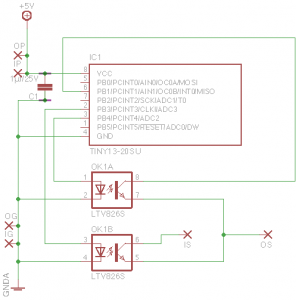So here it goes what I found saved on my computer about Yuneec protocols.
(well... the growing PWM ramp actually doesn't exist - I'm getting older )
)
Probably you found them already, but just in case...
Gimbal signaling :

 www.kopterforum.de
www.kopterforum.de
 www.rcgroups.com
www.rcgroups.com
SR24 zigbee protocol, files attached (only for Q500 and without telemetry ...):
 yuneecpilots.com
yuneecpilots.com
I played a little with the Typhoon H motherboard with stock firmware and I managed to lift it in the air (sort of...) with custom arms and custom motors+props, but due to the inability to tune it I gave it up for the moment.
Initially I wanted to port it to INAV, but my coding skills are close to zero, so even if I able to do the port definitions, I can't compile it (beeing an electrical engineer). Anyhow, INAV doesn't compare to AP/PX4, at least for cinematographic platforms...
Once I wanted to do it to the Phantom3 (having a F427, it would be a good pretender to AP or PX4) , but the H is much easier to port to AP/PX4.
, but the H is much easier to port to AP/PX4.
As a side-note, I found a creepy similarity between the CGO3 and CGO3+ gimbal controllers' hardware and the 32bit version of AlexMos boards . But the research ends here, because they are closed source ones and each of them is somewhat activated and tracked by their S/N.
. But the research ends here, because they are closed source ones and each of them is somewhat activated and tracked by their S/N.
Keep us tuned and best regards,
Zsolt
Edit:
The big hexa is using the stock ESC board? I checked it's power capability and concluded that they are waaay oversized, but no way till 3508-sized motors on 15"
I tested it initially with 2216-810kV on Phantom2 props (9,5"x4,5") but wanted to upgrade to 10"x5" or 11"x5" props, still on the safe side IMHO...
(well... the growing PWM ramp actually doesn't exist - I'm getting older
Probably you found them already, but just in case...
Gimbal signaling :

Horizon CGO2 mit Standard Empfänger schwenken. - Sonstige Tutorials - Tutorials
Die CGO2 lässt sich nicht von einem normalen Empfänger ansteuern der ein Signal im Bereich 1000us - 2000us sendet.Hier eine kleine Selbstbaulösung.
Using CGO2 with standard PWM receiver - Page 3 - RC Groups
Page 3-Mini-HowTo Using CGO2 with standard PWM receiver R/C Blogs
SR24 zigbee protocol, files attached (only for Q500 and without telemetry ...):
Typhoon H / ST-16 controller : Can it be re-purposed?
Just trying to understand some of this post ( way out of my league) what I am trying to find out if I could put a Yuneec flight controller in a 550s frame and run it with the ST16 ???? I think there is a little more to it than that. I'm pretty sure that in addition to the the yuneec flight...
I played a little with the Typhoon H motherboard with stock firmware and I managed to lift it in the air (sort of...) with custom arms and custom motors+props, but due to the inability to tune it I gave it up for the moment.
Initially I wanted to port it to INAV, but my coding skills are close to zero, so even if I able to do the port definitions, I can't compile it (beeing an electrical engineer). Anyhow, INAV doesn't compare to AP/PX4, at least for cinematographic platforms...
Once I wanted to do it to the Phantom3 (having a F427, it would be a good pretender to AP or PX4)
As a side-note, I found a creepy similarity between the CGO3 and CGO3+ gimbal controllers' hardware and the 32bit version of AlexMos boards
Keep us tuned and best regards,
Zsolt
Edit:
The big hexa is using the stock ESC board? I checked it's power capability and concluded that they are waaay oversized, but no way till 3508-sized motors on 15"
I tested it initially with 2216-810kV on Phantom2 props (9,5"x4,5") but wanted to upgrade to 10"x5" or 11"x5" props, still on the safe side IMHO...
Attachments
Last edited:









